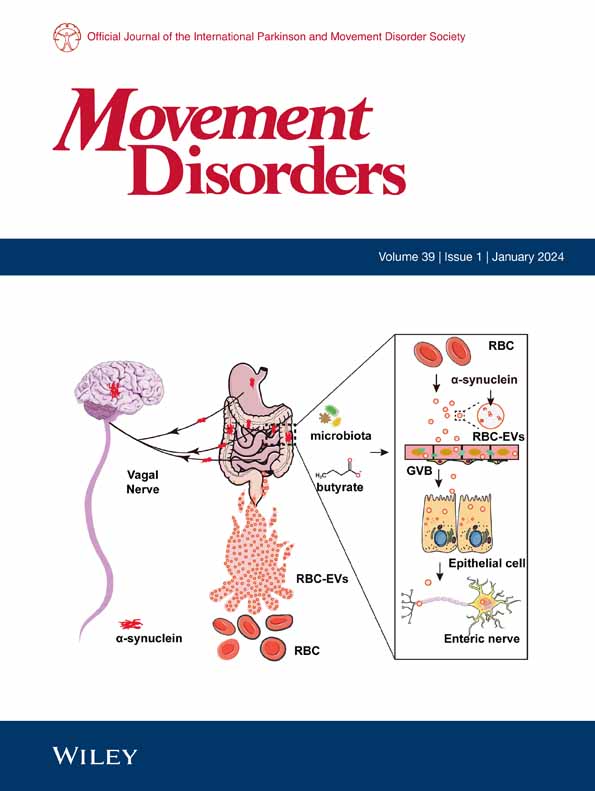Dysregulation of Monounsaturated Fatty Acids is Related to α-Synuclein in Multiple System Atrophy.
IF 7.4
1区 医学
Q1 CLINICAL NEUROLOGY
引用次数: 0
Abstract
BACKGROUND Multiple system atrophy (MSA) is a neurodegenerative disease pathologically characterized by the presence of glial cytoplasmic inclusions (GCI) composed of α-synuclein aggregates. In Parkinson's disease, increases in monounsaturated fatty acids (MUFA) in phospholipid membranes promote α-synuclein binding, aggregation, and toxicity, and the inhibition of stearoyl-CoA desaturase (SCD), the enzyme responsible for synthesizing MUFA, alleviates α-synuclein toxicity. However, little is known about phospholipid MUFA or SCD in the context of MSA pathology. OBJECTIVES To determine whether phospholipid MUFA and SCD levels are altered in MSA brain and related to α-synuclein pathology. METHODS Phospholipid MUFA levels in the disease-affected motor cortex white matter (MWM) and disease-unaffected superior occipital cortex (SOC) of postmortem MSA and control brain were analyzed using liquid chromatography-mass spectrometry. Brain GCI, α-synuclein, and SCD were analyzed using immunofluorescence, Western blotting, and quantitative polymerase chain reaction (qPCR). Serum SCD was analyzed using ELISA. RESULTS MUFA in phosphatidic acid, phosphatidylcholine, and phosphatidylethanolamine were elevated in MSA MWM compared with control MWM by 3.9%, 8.8%, and 9.5%, respectively, whereas none were altered in SOC. MUFA were strongly associated with α-synuclein only in MWM. SCD mRNA and protein expression were decreased only in MSA MWM compared with control MWM. CONCLUSIONS These findings suggest a prevalence of MUFA dysregulation in specific regions of MSA brain, resulting in MUFA levels remaining high despite decreases in SCD expression. Our study has provided new insights into an unrecognized pathway in MSA and opened a new area of research for better understanding MSA pathogenesis. © 2025 The Author(s). Movement Disorders published by Wiley Periodicals LLC on behalf of International Parkinson and Movement Disorder Society.多系统萎缩中单不饱和脂肪酸失调与α-突触核蛋白有关。
背景:多系统萎缩(MSA)是一种神经退行性疾病,其病理特征是存在由α-突触核蛋白聚集体组成的胶质细胞质内含物(GCI)。在帕金森病中,磷脂膜中单不饱和脂肪酸(MUFA)的增加促进α-突触核蛋白的结合、聚集和毒性,而对负责合成MUFA的硬脂酰辅酶a去饱和酶(SCD)的抑制减轻了α-突触核蛋白的毒性。然而,在MSA病理背景下,对磷脂MUFA或SCD知之甚少。目的探讨MSA脑组织中磷脂MUFA和SCD水平是否改变及其与α-突触核蛋白病理的关系。方法采用液相色谱-质谱联用技术分析死后MSA和对照脑病变运动皮质白质(MWM)和未病变枕上皮质(SOC)中磷脂MUFA水平。采用免疫荧光、Western blotting和定量聚合酶链反应(qPCR)分析脑GCI、α-突触核蛋白和SCD。ELISA法检测血清SCD。结果MSA MWM中磷脂酸、磷脂酰胆碱和磷脂酰乙醇胺的smufa含量分别比对照MWM高3.9%、8.8%和9.5%,而SOC中smufa含量无变化。MUFA仅在MWM中与α-突触核蛋白密切相关。与对照MWM相比,仅MSA MWM中SCD mRNA和蛋白表达降低。这些发现提示MSA脑特定区域普遍存在MUFA失调,导致尽管SCD表达降低,但MUFA水平仍保持高水平。我们的研究为MSA未被认识的途径提供了新的见解,为更好地了解MSA的发病机制开辟了新的研究领域。©2025作者。Wiley期刊有限责任公司代表国际帕金森和运动障碍学会出版的《运动障碍》。
本文章由计算机程序翻译,如有差异,请以英文原文为准。
求助全文
约1分钟内获得全文
求助全文
来源期刊

Movement Disorders
医学-临床神经学
CiteScore
13.30
自引率
8.10%
发文量
371
审稿时长
12 months
期刊介绍:
Movement Disorders publishes a variety of content types including Reviews, Viewpoints, Full Length Articles, Historical Reports, Brief Reports, and Letters. The journal considers original manuscripts on topics related to the diagnosis, therapeutics, pharmacology, biochemistry, physiology, etiology, genetics, and epidemiology of movement disorders. Appropriate topics include Parkinsonism, Chorea, Tremors, Dystonia, Myoclonus, Tics, Tardive Dyskinesia, Spasticity, and Ataxia.
 求助内容:
求助内容: 应助结果提醒方式:
应助结果提醒方式:


